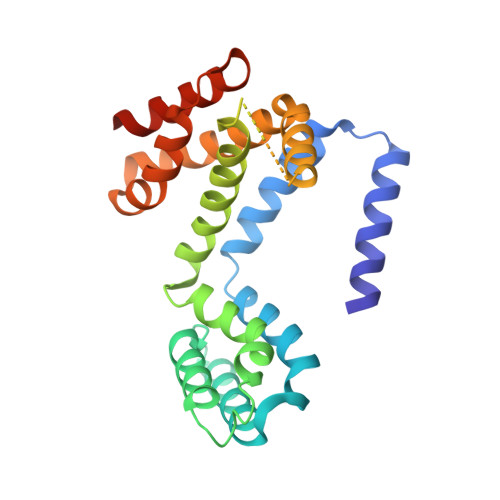Crystal structure of the 500-kDa yeast acetyl-CoA carboxylase holoenzyme dimer.
Wei, J., Tong, L.(2015) Nature 526: 723-727
- PubMed: 26458104
- DOI: https://doi.org/10.1038/nature15375
- Primary Citation of Related Structures:
5CS0, 5CS4, 5CSA, 5CSK, 5CSL - PubMed Abstract:
Acetyl-CoA carboxylase (ACC) has crucial roles in fatty acid metabolism and is an attractive target for drug discovery against diabetes, cancer and other diseases. Saccharomyces cerevisiae ACC (ScACC) is crucial for the production of very-long-chain fatty acids and the maintenance of the nuclear envelope. ACC contains biotin carboxylase (BC) and carboxyltransferase (CT) activities, and its biotin is linked covalently to the biotin carboxyl carrier protein (BCCP). Most eukaryotic ACCs are 250-kilodalton (kDa), multi-domain enzymes and function as homodimers and higher oligomers. They contain a unique, 80-kDa central region that shares no homology with other proteins. Although the structures of the BC, CT and BCCP domains and other biotin-dependent carboxylase holoenzymes are known, there is currently no structural information on the ACC holoenzyme. Here we report the crystal structure of the full-length, 500-kDa holoenzyme dimer of ScACC. The structure is remarkably different from that of the other biotin-dependent carboxylases. The central region contains five domains and is important for positioning the BC and CT domains for catalysis. The structure unexpectedly reveals a dimer of the BC domain and extensive conformational differences compared to the structure of the BC domain alone, which is a monomer. These structural changes reveal why the BC domain alone is catalytically inactive and define the molecular mechanism for the inhibition of eukaryotic ACC by the natural product soraphen A and by phosphorylation of a Ser residue just before the BC domain core in mammalian ACC. The BC and CT active sites are separated by 80 Å, and the entire BCCP domain must translocate during catalysis.
- Department of Biological Sciences, Columbia University, New York, New York 10027, USA.
Organizational Affiliation:
















